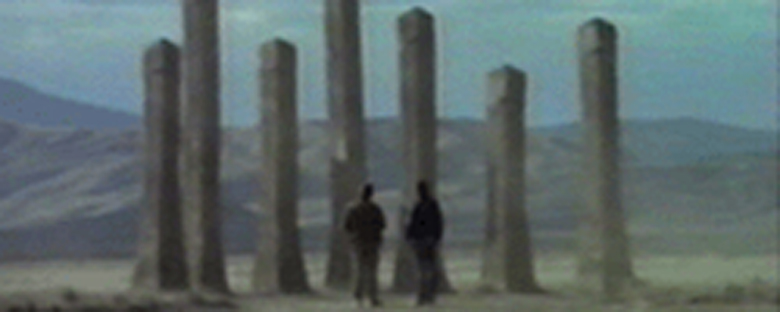Reviews
Saul Bass
UK, 1974
Credits
Review by Thomas Scalzo
Posted on 08 August 2005
Source Paramount Home Video VHS
Related articles
Features: Titles Designed by Saul Bass
Quiet, haunting, beautiful, Phase IV is an intriguing, and largely overlooked, science-fiction masterwork centered on the latent destructive power of the insect world and humanity’s inherent vulnerability in the face of catastrophic change. The feature film debut of renowned title designer Saul Bass (the man behind the vivid credits sequences from Psycho, Vertigo, North by Northwest, and a slew of others), Phase IV shows Bass to be adept at both crafting a vibrantly visual film, and weaving together the elements of an enthralling and thought-provoking science-fiction tale.
The action of Phase IV opens on a desolate stretch of North American desert, Bass taking full advantage of the naturally stark hues of the landscape by imbuing scene after scene with sharp browns, oranges, and yellows. As our attention is attracted by a series of close-ups of ants, a voice-over lecture begins that highlights the abilities and potential strength inherent in this most insignificant of god’s creatures. For several successive scenes, we are offered a comprehensive entomological education, the narrator pausing only for the briefest of moments to allow the viewer to absorb the immensity of the information being conveyed. Surprisingly, this detail-heavy and actor-less montage is a riveting cinematic sequence. The beauty of the location, the astonishing variety of ants photographed, and the startling revelations about the ants’ potential impact on human society are more than enough to engage us. And the patient, thoughtful, and deliberate pacing established in these opening shots prepare us for the studied and rhythmic flow of the narrative that follows.
The human story of Phase IV concerns the efforts of Doctor Hobbs, and James, his hired assistant, to make sense of a recent rash of bizarre ant activities. While nearly everyone else in America has dismissed the ants’ odd behavior (including the construction of ant towers taller than a man) as irrelevant, Hobbs is convinced that something important, and possibly catastrophic, is happening out in the lonely desert. Securing the necessary cash to fund his experiments, the good doctor and James take up residence in a cramped dome structure and settle in to watch the ants. The working theory is that exposure to an unusual amount of solar radiation has augmented the evolutionary progress of the ants, instilling within them an enhanced intelligence, and possibly, a collective consciousness imbued with notions of territorial expansion.
In the hands of an impatient and less aesthetically minded director, this tale of imperialistic ant hordes may well have devolved into a giant insect monster movie a la Empire of the Ants or Them!. But Bass keeps his story planted firmly in the realm of the believable featuring regular-sized ants, and filtering any talk of enhanced ant abilities through the sober lens of science. Instead of employing his crawling nemeses to sensationalistic effect (much as Them! features gigantic mandibles crunching rib cages and Empire of the Ants centers on gargantuan insects emitting effluvial, brainwashing pheromones in hopes of creating sugar factory slaves), Bass gives us feasible scenarios that are all the more frightening for their grounding in reality. Thus we have ant legions chewing through wires and disabling a much-needed truck, surreptitiously conking out the dome’s essential air conditioner, and, in the most gruesome moment of the film, collectively devouring a man from the inside out. Under Bass’ direction, however, even such moments of the macabre are imbued with such eerie beauty that we cannot help but revel in the sublime photography, even as we recoil from the horror.
Aside from the visceral, immediate horror of the film, however, there is a deeper, more sinister idea at work. As the film progresses, and we watch as Hobbs is slowly consumed by a maddening, ant-bite-induced fever, and James struggles to find a way to communicate with the ants, we realize that the fate of these two solitary souls is ultimately irrelevant to the bigger story. Live or die, our heroes are simply the first impediment to the ants’ ultimate conquest of all civilization. Knowing that Hobbs, a thoughtful man of science cognizant of his enemy’s power, is unable to prevent being consumed by it, we must face the realization that the rest of humanity is doomed, that all our efforts to stop the ants will likely prove fruitless. Thankfully, as Phase IV marches toward this desperate conclusion, Bass refrains from showing us the creeping apocalypse, content to merely set the stage and instill within us all a chilling premonition of what may well come to pass.
We don’t do comments anymore, but you may contact us here or find us on Twitter or Facebook.



